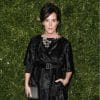“Wolf hair. That’s the weirdest thing in my handbag,” Joan Smalls reveals to the fascinated, if somewhat perplexed crew on the set of BAZAAR’s cover shoot. “I met a lady at the airport who rescues wolves. She had wolf hair in a little vial and she gave it to me for good luck, to always keep with me,” she explains. Whether her stellar ascent through the world of modelling is due to the efficacy of canine-derived good luck charm or not, the intensity behind Joan’s eyes and the cliff-edge curves of her cheekbones are undeniably feline. Today, transformed into a lioness for BAZAAR Joan prowls her territory—an otherworldly enclave in the desert three hours outside of LA—with the ferocity of a wildcat guarding her den.
It feels apt that Joan is channelling the most regal of creatures for BAZAAR, given that she, too, is perched at the very top of her game. Models.com calls her the “world’s foremost model”, while her entry in the most recent Business of Fashion 500 cites Joan as being “one of the most sought-after figures within the fashion industry”. From starring in a new Netflix film this month, dancing in a Beyoncé music video and name-checked in Kanye West lyrics, to seducing us into buying Estée Lauder’s latest from billboards beamed around the world, Joan is a face that has infiltrated the global consciousness.

A psychology graduate in her home country of Puerto Rico, Joan moved to New York to pursue a career in modelling in 2007. Her big break came three years later, when, following a move to star-maker agency IMG, she was booked to walk exclusively for Riccardo Tisci’s Spring/Summer ’10 Givenchy couture show. Suddenly transported into the upper echelons of the industry, Joan has not looked back; her high-fashion editorial work complemented that lucrative Estée Lauder contract she had signed in 2011—the first Latina model to represent the cosmetics giant. Covers of all the major glossies followed; she walked the Victoria’s Secret show from 2011 to 2016; and Cindy Crawford’s a fan.
Truth be told, the 29-year-old could comfortably hang up her Off-White for Jimmy Choos and head into the sunset with long-term boyfriend Bernard Smith. However, while her surname may be Smalls, her ambition is anything but.
“I feel like you shouldn’t put a cap to your ceiling, because once you do, you feel like you’ve achieved it all. It’s about growing and continuing to dream. And once you accomplish that goal you should aim for something else,” she says.
While her initial foray into modelling saw her appear in department store catalogues and campaigns for mid-market “mum” brands, Joan was never going to be satisfied until she reached the top. So, how did she do it?
“I guess I made my career happen by being determined, and just seeing your outcome, regardless of the journey it takes,” she explains. “Always surround yourself with people that believe in you like you believe in yourself, and who are creative and who inspire you. That’s the main recipe for success.”
A constant entry in Forbes’s top 20 Highest-Paid Models ranking, Joan’s annual earnings peaked at an estimated USD5.5 million in 2015, income that she invests prudently. “I’m actually really good with money. I don’t spend a lot,” she smiles, adding, “I splurge every once in a while on a great vacation or if I like a piece of jewellery that I think is cute, but for the most part I save my money and think wisely. I’m a Cancerian so you need to have a plan. I’m kind of a squirrel,
I just love stashing things away.” It’s a measured approach for a career where young girls can earn fat pay cheques, finding themselves at the epicentre of an industry contrived on the temptation to go on the mother of all spending sprees.
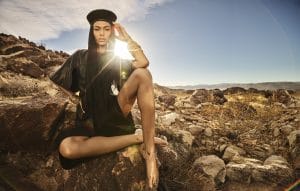
“With this industry, you never know when your next job is going to be, so you have to be astute with how you spend,” Joan counsels. In part, she puts her prudence down to her upbringing and parents who taught her “to try and be as independent as you can and not to have to rely on anyone but yourself and just to be wise and don’t live above your means.”
Like the lioness guarding her territory, so Joan has been quietly investing in real estate with entrepreneur boyfriend, whose Modellounge business includes an apartment in New York where models can stay during Fashion Week. Bernard founded Modellounge in order to create a members’ club-type environment offering a safe space to models in the city to hang out between castings and jobs. With men banned from entering, it’s a timely proposition giving the revelations over abuses in the modelling world that have come to light of late.
“You have to be aware of your surroundings and the environment that you’re in and protect yourself,” Joan says of forging a career as a young model. “I have been very fortunate to work with people who have respected me, but you do hear about things that have happened,” she adds. So, other than more safe spaces like Modellounge, what needs to change to protect vulnerable models from predatory behaviour?
“It comes down to the individual. Meaning everyone, from people not sweeping things under the rug, to the individual speaking out if you see something unjust. Even if you see someone next to you; speak up if you see they don’t have the strength to do that. Encourage them to have that courage and strength. It’s about being empathetic with one another, being supportive and not being tolerant of things that go against your own values and morals.”
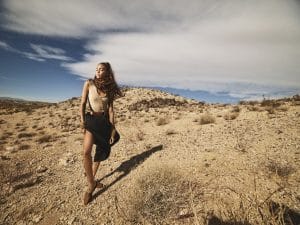
Top; and trousers, both from Chloé. Bracelets, all from Ippolita, David Yurman, Kendra Scott, and Marco Bicego. Shoes, Hermès. Ankle jewellery, stylist’s own.
She recognises the power that the entertainment industry has collectively harnessed using #MeToo and the Time’s Up initiative, lending a voice and support to those abused, silenced, and ignored. “Hollywood has always been that one thing that everyone wants to attain and aspire to, it’s so glamorous and so far to reach,” she says of an industry rocked by widespread allegations of sexual misconduct, adding, “It demonstrates that no one is safe and we can all be affected by it.”
Beyond Hollywood, beyond modelling, Joan is adamant that all women and men should be safe to work in an environment built on respect, not abuse of power, and that the high profile discussion generated by these industries will hopefully filter out to the global workspace. “People are acknowledging that there was unfair treatment of women in the workspace; sending a message to the world and to different industries that we, too, are recognising that there’s been fault and that victims shouldn’t feel alienated. That they are heard and understood,” she says. “It goes to show that nobody is immune to being bullied or attacked or made to feel uncomfortable in different workspaces. Know that together we all are stronger with the support of each other and that it’s okay to speak up and you don’t have to put up with it.”
Refreshingly, Joan practices what she preaches, using her social media platforms (hello 2.6 million Instagram followers) to highlight social injustices, such as the burgeoning trade in migrants and refugees sold into slavery in Libya. “I read these horrible stories and it was just baffling to me that, the year that we’re in, people are taking advantage of other people’s misfortune. That broke my heart as a human being; to just use and abuse and not see someone for a human being. That could be any of us and I think that’s a world problem, it’s not just about Libya, we should all be concerned that people are putting each other through that.” While the majority of her posts are more standard supermodel fare (fragrance campaigns, red carpet moments, and candid backstage shots), she is keen to weave awareness-raising into her followers’ feeds, “so they start reposting and being more socially conscious,” she adds.
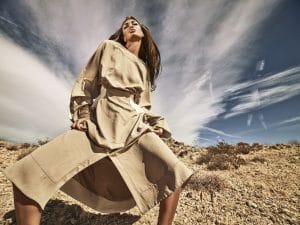
Top; and skirt, both from Loewe. Bracelets, all from Ippolita, David Yurman, Kendra Scott, and Marco Bicego.
Of course, as a “money girl” Joan plays the social media game with the best of them, granting her followers a behind-the-scenes glimpse of herself from off-duty kook to high-octane glamour-puss. “Social media is an escape and you just want to laugh or smile or share a moment, so you have to keep a good balance,” she explains. Somewhat ironically for a model, Joan mourns the loss of deeper insight that social media has sacrificed on the altar of image.
“Because of social media, everything is so visual. People always want to see things instantly and sometimes it takes away from the true sense of self because you’re constantly looking at something because it looks nice,” she muses. As for negative comments, “Yes, I have gotten bad ones. Everybody gets bad ones,” she shrugs. “Do I let it affect me? For a brief second, I catch a little bit of an attitude and then I have to remind myself that I don’t know this person and everyone has an opinion and they are entitled to it. But it’s not going to affect my life, I’m going to continue living. It’s a virtual comment, you just read it and keep moving.” Easy as that? “It’s a lot of pressure, constantly having people judge you …”
But? “There are more serious issues and there are deeper things,” she concludes wryly.
Besides, Joan is a part of the modelling girl gang who always have each other’s backs, frequently forming chat groups for whoever’s in town during Fashion Week. “In one group is Lily [Aldridge] and Doutzen [Kroes], and in another group it’s like Kendall [Jenner], Bella [Hadid], Hailey [Baldwin], Derek Blasberg sometimes—it varies,” she shrugs of the casual name drop. “Supporting other women is about celebrating each other and being happy for one another,” Joan explains of the positive vibes her fellow models spread.
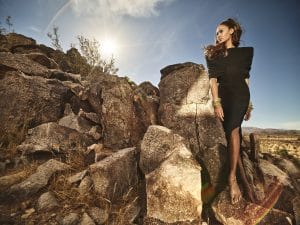
Dress, Tom Ford. Bracelets, all from Ippolita, David Yurman, Kendra Scott, and Marco Bicego. Ankle jewellery, stylist’s own.
“When you see one achieve it means that we all achieve; not thinking that it has to be either her or me. We all have a time to be great, there’s room for all of us.” Perhaps tales of girlish cat fighting in the modelling world were, to an extent, myths perpetuated by the male elite to further exploit their power.
“You make good friends and you root for one another and you cheer each other on,” Joan says of her catwalking cohorts. “It can be competitive just like any industry, but if anything I would say I’m more competitive with myself than I am with another female.”
Hailed as the first Latina model to be signed by Estée Lauder, Joan—whose father is Afro-Irish, while her Puerto Rican mother has Spanish, Taíno Indian, and South Asian ancestry—has already broken barriers in the race space, but it maintains that there is still not enough diversity in modelling. “It should be equal playing grounds for everyone and not that it should come down to race, age, colour, sexuality; people should just be loved and respected for who they are as an individual,” she says. “Growing up as a child, you want to be like, ‘Oh my god, she kind of looks like me! I’m accepted in the world, people see me as beautiful.’ If you can’t identify with someone then it makes you question, are you beautiful enough?”, she explains of the importance of genuine diversity in imagery. “When you walk outside your door, you don’t just see the same face every single time, you see different personalities with different faces, different attributes, so why not represent the world we currently live in?” she challenges. “Part of being beautiful is like a rainbow—you have all shades, all colours, all sizes—and that’s the true essence of beauty.” It’s a message that she hopes is getting through.
“Little by little, all of that is starting to turn around and brands are realising there’s a bigger demographic outside of their own agenda,” she says. After all, as this wolf in lioness’ clothing observes, “Last time I checked, everybody buys clothes, everybody buys make-up, so why not include the whole world?”
Catch Joan Smalls in the comedy film Set It Up on Netflix opposite Lucy Liu, Glen Powell, and Zoey Deutch.



